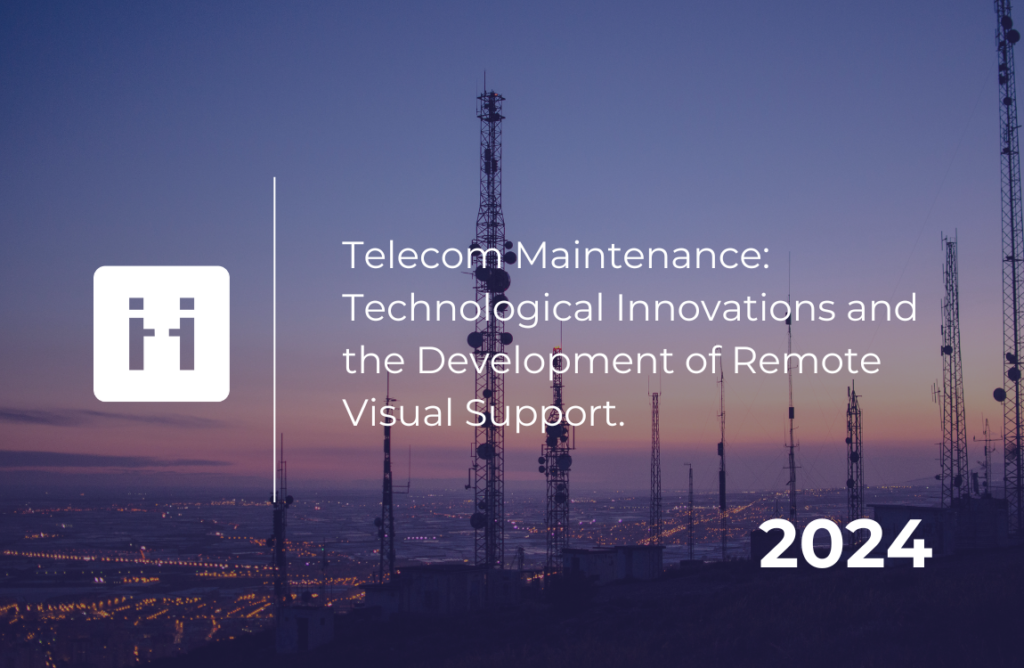In a constantly evolving sector like telecommunications, infrastructure maintenance is of paramount importance. Recent technological advancements offer unprecedented opportunities to improve the efficiency and precision of work orders.
How are technologies like 5G, Artificial Intelligence, or Augmented Reality revolutionizing telecom maintenance? What are the future prospects and challenges of remote visual support in this field?
What are the major technological innovations in telecommunications?
Characteristics and Advantages of 5G
5G offers significant improvements in speed, latency, and capacity compared to previous generations. It promises data rates of up to 10 Gbps, which is about 100 times faster than 4G. This speed increase allows for near-instant data transfers, facilitating the use of applications that require high bandwidth.
Artificial Intelligence (AI)
-
Applications of AI in Telecom Maintenance
Artificial Intelligence (AI) is one of the most significant technological innovations in recent months. Its applications in telecom maintenance are numerous and varied, transforming traditional methods of network and infrastructure management. AI can analyze vast amounts of data from equipment and networks, identifying potential patterns of failure or malfunction.
-
Using AI for Predictive Diagnostics and Work Orders Planning
Moreover, AI is particularly effective for predictive diagnostics and work order. By using machine learning algorithms, systems can predict failures before they occur, based on historical and real-time data. This allows maintenance teams to proactively plan work orders, reducing downtime and increasing network reliability.
With these capabilities, AI not only optimizes operational efficiency but also contributes to more strategic and anticipatory management of resources and work orders.
Augmented Reality and Remote Visual Support Tools
Augmented Reality (AR) represents a major advancement in telecommunications, especially in terms of remote visual support. With the integration of AR into remote visual support tools, field technicians can now benefit from enhanced visual support.
AR Use Cases for Maintenance Technicians
The use cases of AR for maintenance technicians are varied and numerous: real-time visualization of a machine’s internal components, identification of faults without having to consult complex manuals…
AR also facilitates continuous training by offering interactive simulations and virtual guides, which improves the skills and responsiveness of technicians.
Advantages of Remote Visual Support for Telecom Maintenance
Reducing First Time Fix rate
Remote visual support significantly reduces the time required to resolve technical issues. With a real-time video connection, field technicians can immediately share what they see with remote experts. This instant collaboration allows for faster diagnosis and correction of problems, eliminating the need for multiple trips or prolonged waits for specialized advice.
Improving Diagnostic Accuracy with Remote Expertise
Remote visual support also improves diagnostic accuracy by providing direct access to specialist expertise. Experts can view problems live and provide precise instructions for resolving them using visual annotations and indications. This approach reduces the risk of errors and ensures that proposed solutions are based on a thorough, real-time analysis of field conditions.
Real-Time Training and Support for Field Technicians
Furthermore, remote visual support serves as a tool for ongoing training and support for technicians. New employees can be guided remotely by experienced trainers, learning best practices directly in the field. This real-time support allows technicians to gain skills and confidence while ensuring high service quality. Additionally, technicians can consult experts at any time, promoting effective problem resolution and continuous learning.
Impact and Synergies Between Technological Innovations and Remote Visual Support
How 5G Improves the Quality and Reliability of Real-Time Video Connections
The advent of 5G revolutionizes remote visual support by offering ultra-fast connections and extremely low latency, which is crucial for real-time video communications. 5G enables smooth and stable video streaming, even in demanding or remote environments. This ensures that field technicians can send and receive high-quality video without interruption, facilitating effective and immediate remote expert support.
The Role of AI in Analyzing Video Streams for Automated and Assisted Diagnostics
Artificial Intelligence (AI) plays a central role in enhancing remote visual support services by analyzing video streams for faster and more accurate diagnostics. Using advanced image recognition and data processing algorithms, AI can now automatically detect and identify anomalies or faults in telecom equipment. This automated analysis provides real-time recommendations to technicians, improving the precision and efficiency of work orders.
The Contribution of AR to Enriched and Interactive Visual Support
Augmented Reality (AR) enriches the remote visual support experience by overlaying digital information directly onto physical equipment. Technicians can visualize detailed instructions, interactive diagrams, and real-time annotations while keeping their hands free to work.
This interactive visual support not only facilitates understanding of complex tasks but also reduces errors and work order time, making maintenance operations more efficient and secure.
Remote Visual Support and Telecom Maintenance: Future Prospects and Challenges
New Business Opportunities for Telecom Companies
Remote visual support opens new business prospects for telecom companies. By offering remote maintenance services, these companies can extend their geographical reach without requiring frequent travel, thus reducing operational costs. Moreover, remote visual support allows for premium services such as advanced diagnostics, real-time support, and increased revenue sources and customer loyalty. The ability to train and certify technicians remotely also expands partnership and growth opportunities.
Challenges Related to Security and Privacy of Video Data
However, the growing adoption of remote visual support brings significant challenges in terms of security and privacy of video data. Live video streams can contain sensitive information about customers’ infrastructure and operations. Protecting this data from cyberattacks and unauthorized access is crucial. Companies must invest in robust encryption solutions and implement strict security protocols to ensure the confidentiality and integrity of data exchanged during work orders.
Regulation of AI and Remote Visual Support Use in Telecom Maintenance
Finally, regulating the use of AI and remote visual support in telecom maintenance is another major challenge. Legislators and regulatory bodies need to establish clear frameworks to ensure these technologies are used ethically and securely. This includes managing intellectual property rights, liability in case of AI-assisted diagnostic errors, and protecting users’ personal data. Adequate regulation is essential to foster innovation while ensuring customer trust and compliance with legal and ethical standards.

